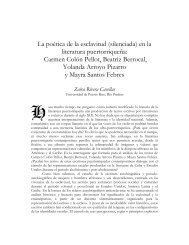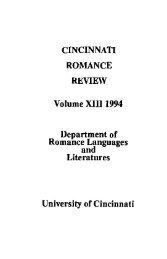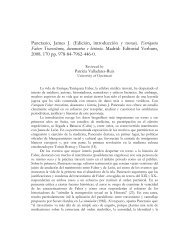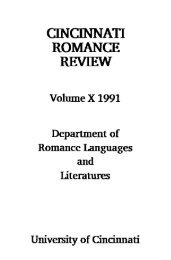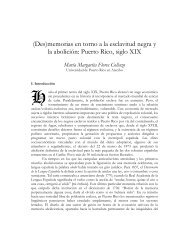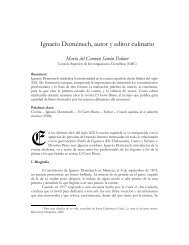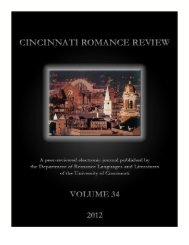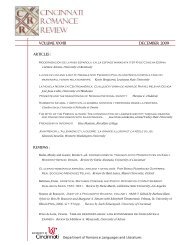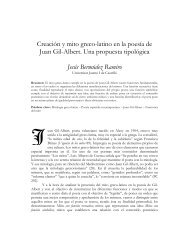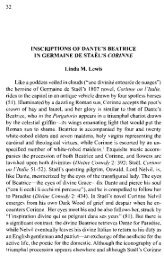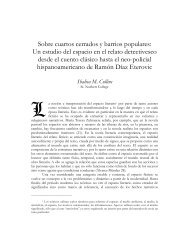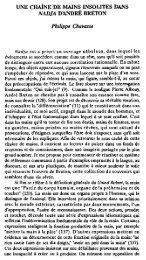Volume 30 (2011) - Cincinnati Romance Review
Volume 30 (2011) - Cincinnati Romance Review
Volume 30 (2011) - Cincinnati Romance Review
You also want an ePaper? Increase the reach of your titles
YUMPU automatically turns print PDFs into web optimized ePapers that Google loves.
WRITING AFRICANS OUT OF THE RACIAL HIERARCHY<br />
relied on the same sort of pseudo-scientific assertions as North Atlantic ideas and<br />
because they failed to challenge many essential notions of the North Atlantic<br />
ideologies—namely that Asian, African, and indigenous American peoples were racially<br />
inferior to Europeans and their descendents. Another major problem with embracing<br />
multiculturalism with the caveat that it involve either miscegenation or the assimilation<br />
of perceived “problem” groups to mainstream European based beliefs, practices, and<br />
lifestyles is that it does not represent genuine tolerance. In the ideology of mestizaje,<br />
“problem” groups are viewed as having no merit in their own right. While the<br />
achievements of their ancient ancestors might be appreciated, in the present they are<br />
either only valuable in what they can contribute to a new, superior mixed race group or<br />
can only be salvaged through assimilation to mainstream “mixed” culture, which rarely<br />
contains any vestiges of their practices and beliefs. In this respect the Mexican<br />
nationalist concept of mestizaje differed little from the Social Darwinist ideas of the U.S.<br />
and Europe: both devalued the practices and supposed racial characteristics of non-<br />
European groups in their own right.<br />
Gamio, Vasconcelos and Paz<br />
Jose Vasconcelos Calderon was perhaps the most influential individual in<br />
restructuring Mexican education during and following the revolution. Having already<br />
distinguished himself as a promising young intellectual during the Porfiriato, he broke<br />
with positivism in the academy and supported Francisco Madero’s uprising against Diaz<br />
(Meyer et al 127). Under Madero's rule he led structural changes to the Escuela Prepatoria.<br />
In 1914 he was appointed minister of education, only to be exiled from 1915-1920<br />
under Venustiano Carranza. When he returned to Mexico in 1920 he began a series of<br />
significant positions related to education, first directing Universidad Nacional Autonima de<br />
Mexico (UNAM), then creating the Ministry of Public Education and serving as the first<br />
Secretary of Public Education under Alvaro Obregon. 4 In that capacity he determined<br />
public curriculum, chose new textbooks for Mexico’s pupils, and undertook policies<br />
designed to incorporate Mexico’s indigenous citizens into the mestizo mainstream<br />
(Meyer 427-29). He published his most well known work, La Raza Cósmica, at the height<br />
of his public service in 1925. 5<br />
La Raza Cósmica was significant not only in shaping popular attitudes about race<br />
in Mexico but also in shaping public policy. Vasconcelos intended it to be a nationalist,<br />
anti-U.S. treatise that would lead to a stronger, more unified and inclusive Mexican<br />
society. Central to the creation of a Mexican national character, according to<br />
4 Paz states that Vasconcelos’ influence was “at its strongest…when he became Secretary of<br />
Public Education under Alvaro Obregon” (140).<br />
5 For more on Vasconcelos, see Luis A. Marentes (2000), Francisco Juárez Nicandro (1967), and<br />
Kelley Swarthout (2001).<br />
<strong>Cincinnati</strong> <strong>Romance</strong> <strong>Review</strong> <strong>30</strong> (Winter <strong>2011</strong>): 172-183.<br />
177



